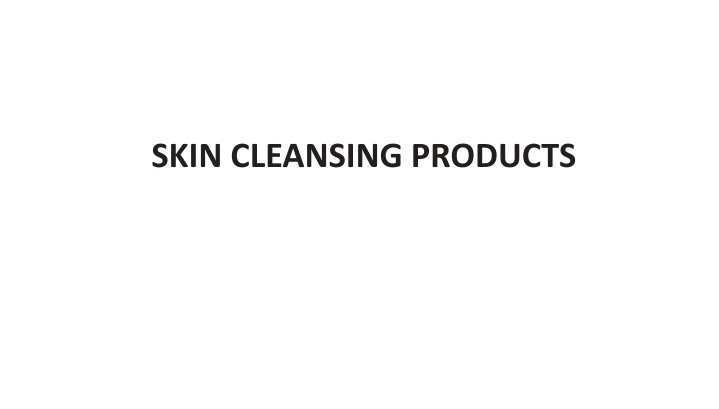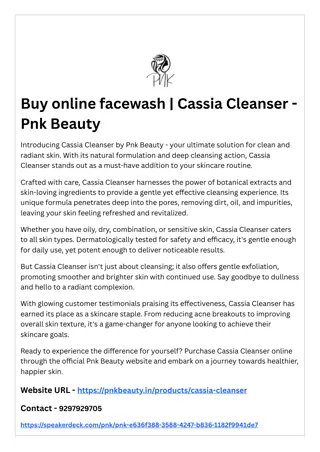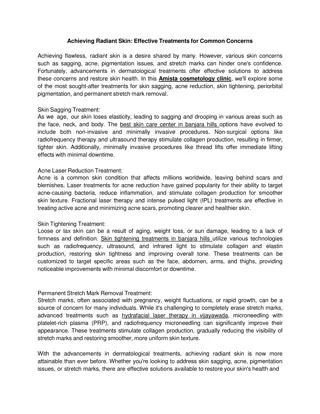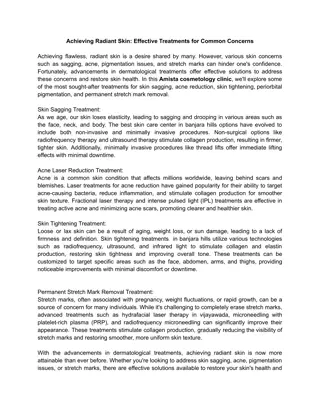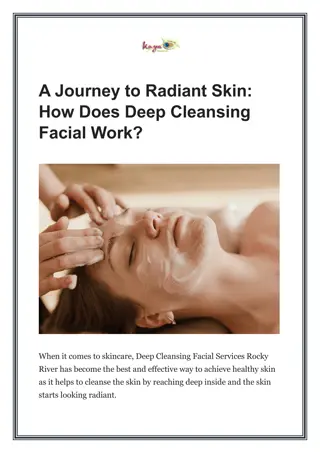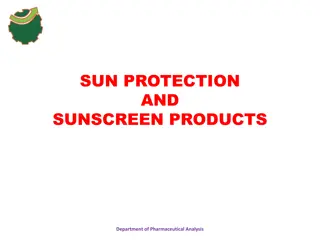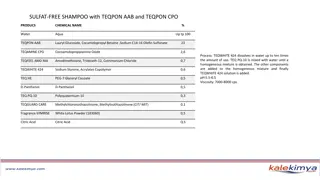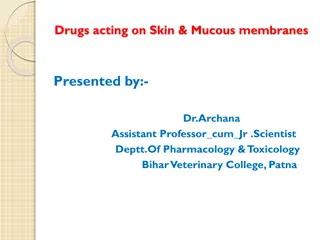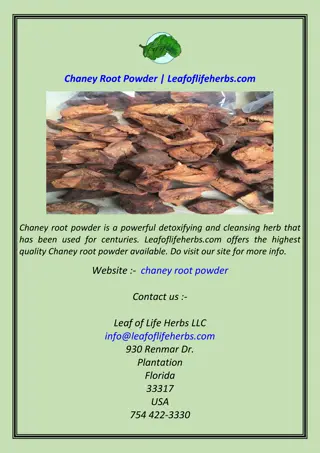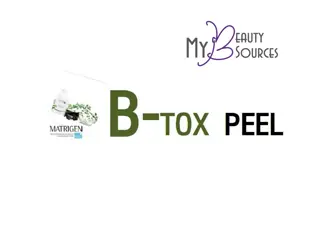The Effects of Skin Cleansing Products on Skin Health
Skin cleansing is essential for maintaining healthy skin, but some cleansers can lead to skin barrier damage, dehydration, and irritation. Surfactants in cleansing products can disrupt the skin's structure and impact its barrier function, potentially causing dryness, redness, and itching. Additionally, certain surfactants may have varying levels of potential to damage skin proteins, with anionic surfactants posing the highest risk. It is crucial to be mindful of the ingredients in skin cleansing products to prevent negative effects on the skin.
Download Presentation

Please find below an Image/Link to download the presentation.
The content on the website is provided AS IS for your information and personal use only. It may not be sold, licensed, or shared on other websites without obtaining consent from the author.If you encounter any issues during the download, it is possible that the publisher has removed the file from their server.
You are allowed to download the files provided on this website for personal or commercial use, subject to the condition that they are used lawfully. All files are the property of their respective owners.
The content on the website is provided AS IS for your information and personal use only. It may not be sold, licensed, or shared on other websites without obtaining consent from the author.
E N D
Presentation Transcript
SKIN CLEANSING PRODUCTS Human skin is in continuous contact with the environment, which can modify its normal flora, pH, and barrier properties, leading to unwanted conditions. Skin cleansing serves as a foundation for healthy skin with an intact barrier function, and it also contributes to the skin s aesthetic appearance. It includes the removal of dirt, oil, cosmetics, and dead skin cells. In addition, skin cleansing is the initial step in overall skin care and prepares the skin for the application of moisturizing, protective, and nourishing products.
How Skin Cleansing Products May Affect the Skin? Dirt found on our skin consists of sweat, sebum and its breakdown products, dead skin cells, residues of cosmetics and personal care products applied to the skin, dust, and other environmental impurities carried in the air. Most of these compounds are not soluble in water, so washing the skin with simple water would not be sufficient to remove dirt.2 Skin cleansing products contain surfactants that are capable of emulsifying water-insoluble ingredients into micelles, which can be easily washed away from the skin.
Unfortunately, many skin cleansers do cause changes in the skin s structure and barrier function, leading to irritation, dryness, redness, and itching. The major negative effects of skin cleansers and additional concerns are summarized as follows:
Dehydration of the skin and weakening skin barrier: Many skin cleansers solubilize lipids that are found on the skin surface to provide protection and may even extract skin components, such as the NMF (natural moisturizing factor) during cleansing. Surfactants may also remain in the SC after even rinsing the product with water. Surfactants can disrupt the SC s structure, and weaken its barrier function leading to dehydration of the skin. Surfactant penetration can cause irritation and inflammation and alter barrier renewing processes by affecting desquamation.
Damage of skin proteins It has been shown that the tendency of surfactants to damage skin proteins is related to the charge density of the surfactant aggregates. This explains the following well-known order for the irritation potential of surfactants, namely, anionic surfactants > amphoteric surfactants > nonionic surfactants.
Damage of skin proteins As cleansing products are primarily based on anionic surfactants, approaches have been developed to decrease the tendency of these surfactants to damage skin proteins. Common approaches include increasing the size of the head/polar group of the surfactant and using a combination of anionic surfactants with amphoteric or nonionic surfactants.
SC damage Another factor that may contribute to SC damage is the cleanser s pH. Soap-based cleansers are alkaline in nature, while the pH of most syndets (synthetic surfactant-based cleansers) is close to neutral or slightly acidic. Soap-based cleansers have a higher potential to irritate skin than cleansers with synthetic surfactants (syndets).
Irritation, itching, inflammatory responses, and allergies Surfactant or other ingredients penetrate into dermal layers to trigger such conditions. An increase in the production of cytokines can also elicit a response from the dermis. If soaps damage the skin barrier, they can easily get into the deeper layers of the SC, leading to irritation, reddening, and itching.
Resistance of microorganisms A number of hygiene products, including many with antimicrobial activity, have become available. It has been demonstrated in clinical studies that antibacterial agents, such as ethanol, isopropanol, chlorhexidine, are effective in preventing diseases. However, concerns have arisen with regard to the long-term safety of some ingredients. It is questionable whether some ingredients may increase the resistance of microorganisms to antimicrobials. If these agents increased the resistance of antibiotic resistance, it may lead to an increase in the number of multiresistant microorganisms, increasing costs for patients and their families, and even the number of deaths in healthcare settings.
Long-term changes in the skin There are some occupations where frequent hand washing is a must; examples include healthcare settings, such as pharmacies and hospitals; pharmaceutical manufacturing companies; as well as the food industry. In such cases, frequent handwashing may lead to long- term changes in the skin, such as chronic damage, irritant contact dermatitis and eczema, and concomitant changes in skin flora.
Classification of cleansers based on: Cleaning Principle Chemical Nature and Mildness Soaps Foamability Product Type Application Chemical Emulsifying Foaming Facial Solid Synthetic Surfactants Low foaming Bath and shower Liquid Chemical Dissolving Non foaming Semisolid Solvent Hand Physical Sanitizers
Classification Based on Chemical Nature and Mildness Soaps Soaps are salts of fatty acids. If the alkali used contains sodium, potassium, or ammonium ions, water-soluble soaps are formed, whereas zinc and magnesium make insoluble so-called metallic soaps. Skin cleansing products contain water-soluble soaps. The pH of soaps is alkaline and is usually in the range of 9.5 10. This is one of the main reasons why soap-based cleansers can irritate the skin.
Soaps Soaps are amphiphilic molecules having both hydrophilic and hydrophobic groups, i.e., they are soluble in both oil and water. They are anionic surfactants. Soaps are often referred to as natural surfactants since most oils and fats used for their production can be found in nature.
Synthetic surfactants Often referred to as soapless soaps or syndets, They are also amphiphilic compounds. The most frequently used surfactants are anionic in nature, similar to soaps; however, they are much milder to the skin and are, therefore, more popular. The difference in the chemical structure of the molecule and the pH of the final product (usually around pH 7) makes them much milder.
Syndet bars are made using blends of synthetic surfactants, they are a different product, formulation and chemistry to that of traditional vegetable soap bases. Syndet soap surfactants are derived from oils, fats, or petroleum products that are processed in a wide range of chemical processes other than traditional saponification
Solvents Nonpolar solvent-based products, such as those containing mineral oil, may be potentially advantageous for dry skin consumers; however, they may be disadvantageous for users with oily skin. Skin cleansing products containing alcohol can dry the skin, which may be beneficial for oily skin but not for dry skin. It is very important, therefore, to select skin cleansing products in accordance with the skin type.
Classification Based on Cleaning Principle Two basic mechanisms can be attributed to the cleaning effect, namely, chemical cleaning and physical cleaning. Chemical cleaning can be achieved through emulsifying and dissolving the dirt on the face (solvent-based systems).
Emulsifying Surfactants work by reducing the interfacial tension between oil and water, i.e., emulsifying oily components on the surface of the skin with water. The stronger the surfactant, the more hydrophobic material removed, the greater the potential skin damage from excessive removal of naturally occurring skin lipids and the greater the compromise of the skin barrier function. Correct and careful selection of surfactants is required to ensure proper mildness. Soap- and surfactant-based cleansers usually require water and generally include a rinsing step.
Dissolving Solvent-based systems Solvent-based systems clean the skin by dissolving sebum and external oils present on the skin as residues of cosmetics and similar materials. Solvent-based cleansers are usually not used in conjunction with water; rather, they are applied and then wiped off with a tissue or cotton ball.
Physical cleaning is an alternative to chemical cleaning; the working principle is abrasion (friction), which is generated primarily by the direct interaction of a washcloth, tissue, cotton ball, cleansing cloth, or abrasive particles and the surface of the skin. Friction works to help remove dirt and increase the interaction of chemical cleaning agents with oils.
Classification Based on Foamability Foaming cleansers: Contain a significant amount of well-foaming surfactants. These products are the most popular today and often provide the most refreshing sensation afterward. Most body washes, hand soaps, and facial cleansing products belong to this category.
Foaming cleansers: These products are typically surfactant solutions, gels, scrubs, and O/W emulsions with a high cleaning power. Foaming products can contain the same basic ingredients for the body and the face. However, for the face, a different sensation and greater mildness are required. Therefore, generally, combinations of milder surfactants are used. Although these products contain mild surfactants, they can still significantly damage the skin barrier if left on the skin for a longer period of time.
Low-foaming products contain a lower level of well-foaming surfactants compared to foaming products and are milder to the skin. Product forms available as low-foaming products include lotions, gels, scrubs, and creams. They still foam when mixed with water; however, mildness is often obtained at the expense of effective cleansing and lathering.
Low-foaming products These products primarily contain nonionic surfactants, often combined with amphoteric and polymeric types. Foam-booster secondary surfactants may also be added to increase the user experience. Low-foaming products are typically marketed for the face, but in some cases, for the body as well.
Non-foaming include surfactant solutions, creams, lotions, bath oils, bath salts, and toners. Cleansers in this category tend to be the mildest due to their low well-foaming surfactant or soap content. Non-foaming cleansers can be solvent-based, such as facial toners and hand sanitizers, and emulsion-based, such as most facial cleansers, body washes, and hand soaps (which solubilize dirt).
Non-foaming Emulsion-based non-foaming products contain the highest level of oils compared to the other two groups; therefore, they are ideal for depositing a thin layer of oil onto the skin, which remains on the skin even after rinsing. For this reason, these preparations are generally more effective for dry skin users and not recommended for oily and acne-prone skin. They are primarily formulated for the face and, in some cases, for the body. Emulsion-based products are often referred to as moisturizers or emollient body washes.
Classification Based on Product Types Solid cleansing aids, such as soap bars, bath salts, bath beads, and cleansing wipes Liquid products, such as surfactant solutions, low-viscosity emulsions, toners Semisolid products, such as creams, pastes as facial masks, scrubs, and gels. It is important to understand that a cream may be foaming, low-foaming, or non-foaming, depending on the ingredients it is made of.
Classification Based on Application Surface Facial cleansers include lathering and foamless emulsions, gels, scrubs, toners, masks, and cleansing wipes. Bath and shower products such as bar soaps, bath salts, bath bombs, bath oils, bubble bath products and shower gels. Hand cleansing products include bar soaps and syndet bars as well as liquid soaps. They are often enhanced with additional moisturizing ingredients. Hand sanitizers are used specifically to remove microorganisms from the hands with the intent of preventing infections and reducing the spread of infectious diseases. They include bar soaps, gels, lotions, creams, and cleaning wipes.
Typical Ingredients in Skin Cleansing Products Surfactants Solvents Thickeners Skin conditioning agents pH buffers Abrasives Fragrances Preservatives Antibacterial agents Absorbents Astringents Vitamins and exotic natural ingredients Colorants
Surfactants act as cleansing agents and emulsifiers. Anionic surfactants have good lathering and detergent properties, which are necessary to remove dirt. As mentioned earlier, natural soaps are anionic molecules as well. Cationic surfactants have a positive charge which makes them attracted to the skin. Therefore, they can be employed as conditioning agents. Amphoteric surfactants are well tolerated and lather well and, therefore, are also often used in facial cleansers as secondary surfactants to help boost foam, improve conditioning, and reduce irritation.
Nonionic surfactants, are very mild; thus, they are commonly used as emulsifiers, conditioning agents, and solubilizers. Their main drawback is that they do not lather particularly well. However, they form a perfect combination with anionics. Usually, different types of surfactants are used in combination with each other to build appropriate properties into the formulations.
Anionic surfactants have excellent foaming and cleansing power; however, they are generally irritating. Therefore, they are often combined with nonionic and amphoteric surfactants, which act as secondary surfactants and decrease the irritating potential of anionic surfactants and leave the skin with a pleasant feel as well as contribute to foam stability.
Thickeners Surfactant-based products can be thickened by increasing the surfactant concentration; using various hydrophilic thickening agents, such as cellulose derivatives, gums, and acrylic acid derivatives; and, in certain cases, adding sodium chloride. Skin conditioning agents (otherwise known as moisturizers) counteract the SC-disruptive properties of soaps and surfactants. Cleansing agents may contain various types of moisturizers, although part of them is removed from the skin when rinsing with water. Therefore, significant amounts of moisturizers will not be left on the skin surface after cleansing. This is why proper moisturization is important after cleansing the skin for all skin types.
Foam stabilizers are generally surfactants, which do not have a good foaming property by themselves; however, they can improve the stability of foam generated by anionic surfactants. The most frequently used ingredients include nonionic surfactants, such as cocamide DEA. Abrasives Facial scrubs contain specific exfoliating components that are responsible for physical cleaning.
Antibacterial agents are widely used in todays formulations. They may be beneficial for controlling certain skin conditions, such as acne; superficial skin infections, such as folliculitis; and control infections after exposure to dirt or other potential sources of contamination. These are generally considered active ingredients in products. The most commonly used compound is triclosan; however, its safety and efficacy are currently being investigated in cleansing products by the FDA. Additional examples include benzoyl peroxide and lactic acid (soaps containing a higher amount of lactic acid have an acidic pH, which is thought to be antibacterial).
Absorbents are mainly used in facial masks to absorb sebum from the skin. These are water insoluble, mainly inorganic compounds. Examples include zinc oxide, titanium dioxide, kaolin, calamine, clay, and natural mud. Astringents are the major ingredients in facial toners. They tighten pores and refresh the skin. Most of them are generally considered active ingredients. Examples include alcohol and witch hazel.
Many consumers focus on whether they have acne-prone or sensitive facial skin, but do not take into account their body skin type. The type of the skin changes over time and may vary even among different body parts in individuals. One may have combination facial skin, normal body skin, and extremely dry hand skin. Therefore, the type of product used should be carefully selected according to the skin s needs.
Products types of cleansers Cleansing Wipes Bar soaps Syndet bars Gels Scrubs Creams and lotions Toners Masks Bath salts Bath bombs Bath beads (i.e., capsules) Bubble bath Bath oils
Traditionally, bar soap made with natural surfactants was used as a skin cleanser. It is effective in removing grime and is relatively inexpensive however, the washing solution formed by soap is extremely alkaline (pH 9.5 11.0) and can cause irritation, dryness, and scaling. Superfatted soaps contain more oil than required to a stoichiometric reaction. The excess oil may serve as a moisturizer and an emollient and improves the mildness of the product
Transparent soaps have a higher concentration of glycerin, which is a skin moisturizer. Although they contain natural soaps and therefore their pH is alkaline, they are still considered milder due to the presence of glycerin. An additional disadvantage of natural surfactants when used in bathtubs is that they tend to form scum and rings on the wall of the tub in the presence of hard water. Soap rings do not rinse away easily. In addition, they tend to remain behind and produce visible deposits on clothing and make fabrics feel stiff.
Syndet bars are similar to soap bars, although they contain synthetic emulsifiers instead of natural soaps. Therefore, syndet bars have a better skin compatibility profile than traditional soaps. Their cleaning effect is very good, and the residue left on the skin is minimal. Due to their more gentle nature, they are becoming more important as skin cleansers. Nearly all common synthetic detergent bars are based on an anionic surfactant, acyl isethionate.
Many consumers relate the shape and name to the harsh effect regular products would cause. Most consumers are not aware that a soap in the form of a bar can be made of different types of surfactants and is, therefore, not necessarily harsh.
Cleansing gels are water-based systems, containing various types of thickening agents they typically have a transparent appearance. Gels are a popular cleansing form; they are used with water since they are foaming formulations. Inert particles (i.e., beads) are often incorporated into gels, which may provide an additional exfoliating effect.
Scrubs are generally O/W emulsions or gels that contain small particles of natural or synthetic origin. Scrubs are intended to provide a deep cleansing effect, including skin exfoliation from abrasion with the particles, and they also polish the skin. It is important to keep in mind that the skin regularly and continuously sheds; therefore, additional exfoliators should not be used every day. They affect the skin barrier and can lead to damage if used too vigorously.
Massaging and rubbing these preparations onto the skin must be done with the utmost care and gentleness and in strict accordance with the manufacturer s instructions. Exfoliating agents help physically remove dirt and cellular debris from the skin and provide a smooth skin surface. They are advantageous for aging skin, acne, and other skin conditions when high exfoliation is required.
Cleansing creams and lotions are typically O/W emulsions. The main difference between a cream and lotion is their viscosity; lotions have lower viscosity. They are usually made of relatively delicate surfactants, and their irritation potential is much lower than that of soaps. They can be lathering, low-foaming, or non-lathering formulations. Although cleansing creams and lotions may deposit moisturizer ingredients on the skin, they should not be used as moisturizers and left on the skin. These products contain cleansing agents that are mild; however, if left on, it may lead to irritation. For the same reason, it is preferable to wash them off the skin than just wiping them off with a dry cloth.
Toners are clear solutions, generally based on various types of solvents and a low amount of surfactants. Waterless cleansers for the face are often based on alcohols and glycols since sebum is soluble in these solvents. Toners are usually applied with cotton balls, tissues, or washcloths and evaporate quickly after application. These products may be beneficial when there is no access to water and can be effective for very oily skin; however, long-term use may be harmful to the skin barrier.
